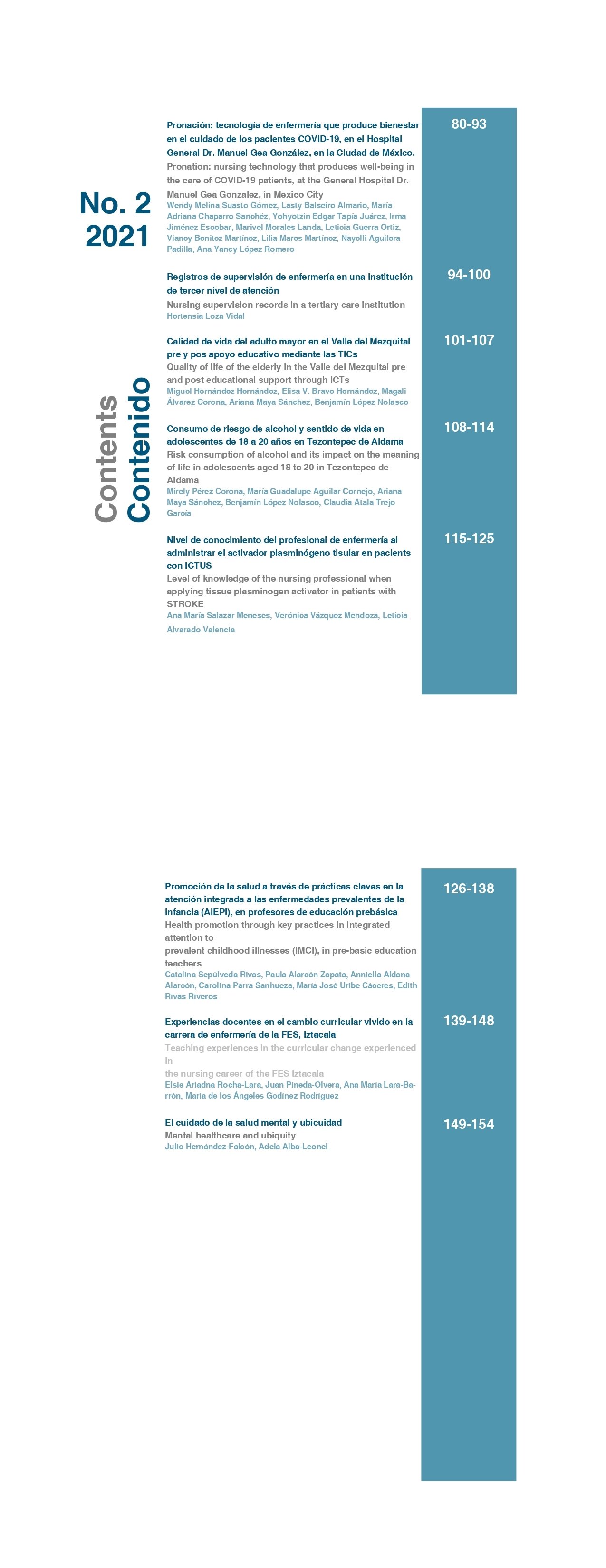Nursing supervision records in a tertiary care institution
Registros de supervisión de enfermería en una institución de tercer nivel de atención
DOI:
https://doi.org/10.51422/ren.v20i2.334Keywords:
supervision, nursing, third levelAbstract
Introduction: the transformations from globalization and the consequent increase in competitiveness have called for changes by organizations. The Nacional Institute of Neurology and Neurosurgery (INNN) Nursing Subdirector should be kepta at the forefront of the supervisory area in particular.
Objective: to develop a nursing supervision model that structures, standardizes and simplifies management functions to ensure quality care and warmth to INNN dependent care agent.
Material and methods: a descriptive analysis was carried out. The information gathering was divided into two stages, together with a pilot test only for the general supervisors, who developed the model. The other was the restructuring of the formats and training of the nursing heads of service and those in charge of the service, from May 28 to June 3, 2018. This work was carried out at INNN, in coordination with the supervisors of the morning, evening, nigth shifts in its two evenings, special day at night.
Results: it was perceived that 56% said that the new format of the critical area has more observations. Meanwhile, the leading nursing staff cites that the spaces of the hospitalization and critical area formats are very small with 64%.
Discussion: in the Specific Organization Manual of the Institute's Nursing Subdirectorate, mention is made of the general and specific functions and responsibilities of general nursing supervision.
Given the above context, we see a need for an update of the supervision model, for innovation that allows systematizing the performance of the nursing professional who exercises the managerial function at different levels of care, contributing to the continuous improvement of the quality of care for the person.
Conclusion: we are aware that the supervision model leads us to success in all its forms, offering better patient care led by the supervisor and thus, maximizing health promotion opportunities and complying with standards and protocols.
Downloads
References
Real Academia de la Lengua. Consultado en: https://t.ly/BhUR (Recuperado: 7 julio 2020)
Collière M F. Promover la vida. Interamericana. Madrid, 1993.
Rosario Niño. Desarrollo histórico del cuidado de enfermería. Consultado en: https://t.ly/yy4B (Recuperado: 7 julio 2020)
Allué Marta. El paciente inquieto. Ediciones Bellaterra S.L. Barcelona, 2013.
Cela Conde Camilo J, Ayala Francisco J. Senderos de la evolución humana. Alianza Editorial. Madrid, 2001.
Naranjo Hernández Y, Concepción Pacheco JA, Rodríguez Larreynaga M. La teoría déficit de autocuidado: Dorothea Elizabeth Orem. Gac Méd Espirit (revista en internet). 2017;19(3):1-11. (citado: 7 julio 2020). Disponible en: https://t.ly/16yU
Camelo Pinzón LM. Teoría de autocuidado-Dorothea Orem. 2016. (citado: 7 julio 2020). Disponible en: https://t.ly/9bKm
Puchol Luis, Puchol Isabel. El libro de las habilidades directivas. Ed. Díaz de Santos. 4ª. Ed. España, 2016.
Almirón Arévalo Virginia, Tikhomirova Alena. Liderazgo transaccional vs liderazgo transformacional. Reidocrea 2015; 4:24-7. DOI: https://doi.org/10.30827/Digibug.34629
Ramírez-Elizondo Noe. Enfermería basada en la evidencia, una ruta hacia la aplicación en la práctica profesional. Enfermería en Costa Rica 2011; 32(1)89-96.
Manual para la mejora de la supervisión y enlace de turno. 40 estándares para la capacitación continua en la práctica de enfermería. 1ª. Ed. Secretaría de Salud. México, 2017. Disponible en: https://t.ly/QYDQ
Published
How to Cite
Issue
Section
License
Copyright (c) 2022 Revista de Enfermería Neurológica

This work is licensed under a Creative Commons Attribution-NonCommercial 4.0 International License.






